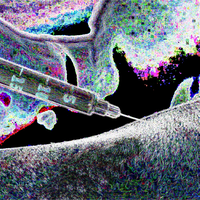| Speed | |
|---|---|
| Salts [] | |
|---|---|
| Amphetamine chlorphenoxyacetate | |
| Amphetamine hemisulfate | |
| Amphetamine hydrochloride | |
| Amphetamine adipate | |
| Amphetamine tartrate | |
| Amphetamine phosphate | |
| Amphetamine hemisaccharate | |
| Amphetamine succinate | |
| Molecular structure via molpic based on CDK |
| Physical properties [] | |
|---|---|
| Molecular mass | 135.21 g/mol [1] |
| Density | 0.913 at 77 °F (EPA, 1998) - Less dense than water; will float g/cm3 [1] |
| Appearance | Mobile liquid [1] |
| Odor | Amine odor [1] |
| Taste | Acrid, burning taste [1] |
| Melting point | 25 °C [1] |
| Boiling point | 392 to 397 °F at 760 mmHg (EPA, 1998) [1] |
| Decomposition | When heated to decomposition it emits toxic fumes of nitroxides. [1] |
| Solubility | Moderate solubility [1] |
| Predicted LogP | 1.8 [1] |
| Structural Identifiers [] | |
|---|---|
| Molecular formula | C9H13N [1] |
| IUPAC name | 1-phenylpropan-2-amine [1] |
| SMILES | CC(CC1=CC=CC=C1)N [1] |
| InChI | InChI=1S/C9H13N/c1-8(10)7-9-5-3-2-4-6-9/h2-6,8H,7,10H2,1H3 [1] |
| InChIKey | KWTSXDURSIMDCE-UHFFFAOYSA-N [1] |
| Pharmacokinetics[] | |
|---|---|
| Elimination half-life | dextroamphetamine: 9 – 11 hours[4]levoamphetamine: 11 – 14 hourspH-dependent: 7 – 34 hours |
| Duration of action | Immediate release dosing: 3 – 6 hours Extended release dosing: 8 – 12 hours |
| Toxicity [] | |
|---|---|
| LDLo | Rat: - intraperitoneal: 23 mg/kg - intravenous: 20 mg/kg Dog: - subcutaneous: 20 mg/kg Monkey: - subcutaneous: 20 mg/kg Rabbit: - subcutaneous: 20 mg/kg - intravenous: 25 mg/kg Guinea pig: - oral: 200 mg/kg - subcutaneous: 20 mg/kg - parenteral: 20 mg/kg |
| LD50 | Rat: - oral: 30 mg/kg - subcutaneous: 180 mg/kg Mouse: - oral: 21 mg/kg - intraperitoneal: 5500 μg/kg - subcutaneous: 15 mg/kg - intravenous: 15 mg/kg Mammal (species unspecified): - oral: 135 mg/kg - intraperitoneal: 65 mg/kg |
| Dosing[] |
|---|
| Insufflated [] | |
|---|---|
| Light | ≤ 13.2 mg(518x - 25.4%) |
| Common | 13.2 - 20 mg(635x - 31.2%) |
| Strong | 20 - 30 mg(449x - 22%) |
| Heavy | 30 - 44 mg(233x - 11.4%) |
| Extreme | 44 mg +(202x - 9.9%) |
| Intravenous [] | |
|---|---|
| Light | ≤ 25 mg(430x - 46.7%) |
| Common | 25 - 30 mg(178x - 19.3%) |
| Strong | 30 - 35 mg(165x - 17.9%) |
| Heavy | 35 - 40 mg(75x - 8.1%) |
| Extreme | 40 mg +(73x - 7.9%) |
| Sublingual [] | |
|---|---|
| Light | ≤ 13.9 mg(2x - 40%) |
| Common | 13.9 - 15 mg(1x - 20%) |
| Strong | 15 - 37.5 mg(1x - 20%) |
| Heavy | 37.5 - 45 mg |
| Extreme | 45 mg +(1x - 20%) |
| Oral [] | |
|---|---|
| Light | ≤ 17 mg(374x - 25.9%) |
| Common | 17 - 30 mg(446x - 30.8%) |
| Strong | 30 - 50 mg(305x - 21.1%) |
| Heavy | 50 - 97 mg(178x - 12.3%) |
| Extreme | 97 mg +(143x - 9.9%) |
| Intrarectal [] | |
|---|---|
| Light | ≤ 40.7 mg(19x - 33.9%) |
| Common | 40.7 - 70 mg(11x - 19.6%) |
| Strong | 70 - 100 mg(15x - 26.8%) |
| Heavy | 100 - 162.5 mg(5x - 8.9%) |
| Extreme | 162.5 mg +(6x - 10.7%) |
Statistically derived dosages via DBI-IGS We do not take any responsibility for medical complications or loss of life sustained by following these dosages blindly. |
Amphetamine
(Redirected from dextroamphetamine)Amphetamine (also known as Amphetamine, Amfetamine, Desoxynorephedrine, Norephedrane, 1-Phenyl-2-aminopropane, Elastonon, Fenopromin, Phenedrine, β-Aminopropylbenzene or Propisamine) is a stimulant substance of the amphetamine class.
Chemistry
Salts []
Amphetamine is typically found in the form of its chlorphenoxyacetate, hemisulfate, hydrochloride, adipate, tartrate, phosphate, hemisaccharate and succinate salts.
Stereochemistry []
Amphetamine is a racemic mixture of the enantiomers
| Stereoisomers |
|---|
Subjective effects
| Anodyne Usernotes [] | |||
|---|---|---|---|
| magnus / Amphetamine[sulfate] via Oral and Insufflation |
0xea / Amphetamine[freebase][sulfate][hydrochloride] via Oral, Insufflated, Intrarectal, Subcutaneous, Intramuscular, Intravenous, Inhaled, Vaporized and Sublingual at 10-50mg oral, 30-60mg insufflated, 30-90mg intrarectal, 10-35mg intramuscular, 15-50mg intravenous and 5mg sublingual | | |
Legal status
- Australia: Amphetamine is a Schedule 8 substance.
- Brazil: Amphetamine is a A3 substance.
- Canada: Amphetamine is a Schedule I substance.
- Germany: Amphetamine is a Anlage III substance.
- New Zealand: Amphetamine is a Class B substance.
- United Kingdom: Amphetamine is a Class B substance.
- United States: Amphetamine is a List of Schedule II controlled substances (U.S.)|Schedule II substance.[3]
- United Nations: Amphetamine is a Schedule II substance.
See also []
External links []
- Amphetamine / Dextroamphetamine (Wikipedia)
- Amphetamine / Dextroamphetamine / Dextroamphetamine (Wikidata)
- Amphetamine / Dextroamphetamine (DrugBank)
- Amphetamine / Dextroamphetamine / Dextroamphetamine (PubChem)
- Amphetamine / Dextroamphetamine / Dextroamphetamine (ChEMBL)
- Amphetamine / Dextroamphetamine / Dextroamphetamine (ChEBI)
- Amphetamine / Dextroamphetamine / Dextroamphetamine (Common Chemistry)
- Amphetamine / Dextroamphetamine / Dextroamphetamine (HMDB)
- Amphetamine / Dextroamphetamine (KEGG)
- Amphetamine / Dextroamphetamine / Dextroamphetamine (UNII)
- Amphetamine / Dextroamphetamine / Dextroamphetamine (EPA DSSTox)
References []
National Center for Biotechnology Information. PubChem Compound Summary for CID 3007, Amphetamine. Accessed October 15, 2025. https://pubchem.ncbi.nlm.nih.gov/compound/3007
U.S. Food and Drug Administration; National Center for Advancing Translational Sciences. Amphetamine. UNII: CK833KGX7E. Global Substance Registration System. Accessed October 15, 2025. https://gsrs.ncats.nih.gov/ginas/app/beta/substances/CK833KGX7E
Ingersoll J. Amphetamine, Methamphetamine, and Optical Isomers. Bureau of Narcotics and Dangerous Drugs}. July 7, 1971. Accessed October 15, 2025. https://archives.federalregister.gov/issue_slice/1971/7/7/12730-12734.pdf
Adderall- dextroamphetamine saccharate, amphetamine aspartate, dextroamphetamine sulfate, and amphetamine sulfate tablet. Teva Pharmaceuticals USA, Inc.. November 8, 2019. Accessed October 15, 2025. https://dailymed.nlm.nih.gov/dailymed/drugInfo.cfm?setid=f22635fe-821d-4cde-aa12-419f8b53db81
 Anodyne
Anodyne